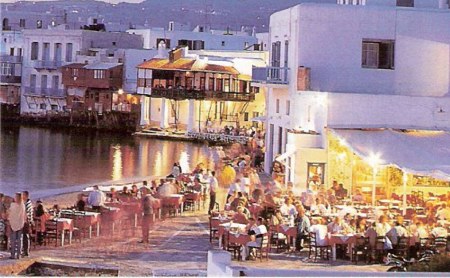|
|
Island Travel: Exotic Island Tourism
By Ron Hall
 Thirthy years ago, before it became swamped by foreign tourism, Skiathos in northern Greece was my ideal holiday island. Less than ten miles long, it boasted no spectacular sites, but it had beaches aplenty, aromatic pine-forested hills, and a town that-because most of its visitors were Greeks-conformed to the natural rhythms of Greek island life: gently active mornings, sleepy afternoons, and long, animated evenings on a waterfront still buzzing with life until well after midnight. At the far end of the island, a large hotel had been built above a famous beach, where 10 bster-skinned package tourists were kept mercifully out of sight. On a concealed peninsula along the island's southern coast was a discreet villa community of English-speaking expats, served by a convivial beach taverna.
It was, in short, a wellordered island that you could safely recommend to your friends, and when my journalist compatriot Harold Evans (who twenty years later was to become the founding editor of this magazine) asked me where to go for a family vacation in Greece, he was duly pointed in its direction. His vacation proved a huge success. Years later, Skiathos oldtimers were still recounting with awe how young Evans, a man of overflowing energy and enthusiasm, had descended on their lethargic expatriate community, decided that things needed livening up, and proceeded to organize a tireless round of yacht regattas, swimming races, Ping-Pong tournaments, island cruises, and nightly partying. The expats all loved it, of course, and eagerly looked forward to his next adrenalinepumping visit.
As a result of all this, Evans was afterward convinced that I was more expert on the backwaters of Greece than perhaps was the case, and when, in 1987, he was working on the launch of Conde Nast Traveler, he called me and said, "You know all about Greek islands, Ron. Why don't you do them for us?" "All right," I said, "but which ones?" "Oh, do them all," he replied airily. I still don't know whether he quite realized that there are more than fifty Greek islands on the tourist beat, but I took him at his word and set off on a hectic twomonth ferryboat tour of Greece, never sleeping in the same bed twice, until each of those fifty islands had been checked out. The subsequent coverage, with pictures and maps, occupied fortyfive pages of the August 1988 issue and sparked a succession of other "Island Finders" and beach surveys that became a recurrent feature of Conde Nast Traveler. After ten years of the magazine's existence, my own personal tally of islands visited is now nudging 250an appropriate moment, perhaps, to stand back and take stock.
THE QUESTION I AM MOST OFTEN asked is the one I find most difficult to answer: Which of all that mosaic of islands are my favorites, the islands to which I most eagerly return? So many personal foibles enter the choice (to say nothing ofthe season, the time available, and the state of my bank balance) that a different list emerges each time. Also, because islands are each so individual and distinct, there are no simple generalities to hide behind. The remotest islands often turn out to be the dullest; the smallest islands are often the most gregarious; the most touristed islands often have the richest culture. However, tempted by the prospect of an aroundthe-world air ticket to test my choice, I agreed to declare, with as much objectivity as I could muster, my definitive Top Ten. These, in alphabetical order, are Anguilla (Caribbean), Bali (Indonesia), Bora Bora (French Polynesia), Capri (Italy), Hvar (Croatia), Kauai (Hawaii), Mykonos (Greece), Ponza (Italy), Upolu (Western Samoa), and Zanzibar (Tanzania).
I was sorry that by limiting myself to ten, I had squeezed out two island-nations that I very much admire-Seychelles, with its exotic vegetation and wildlife, and Mauritius, with its classy beach resorts-but, for me, neither has enjoyable enough village life to make it into the Top Ten. Off the coast of East Africa, Zanzibar was given a close run for inclusion by the Kenyan island of Lamu. In the Caribbean, Anguilla had hot competition from St. Barts and the British Virgin Islands. On the Dalmatian coast of the former Yugoslavia, the island of Hvar (with its wonderful old Venetian town) was preferred to Rab and Korcula (which also have wonderful old Venetian towns).
As can be seen, most of my chosen islands are small. I once described my ideally sized island as one where you could sit down in a strategic spot and be sure that in the course ofthe day, everyone on the island you wanted to see would pass you by-not too often, but at least once. Five of my islands (Mykonos, Zanzibar, Hvar, Ponza, and Capri) pass that test literally, and two more (Upolu and Anguilla) do so metaphorically.
For me it is this social concentration that is the essence of island life and that makes such a contrast with the anonymity of mainland travel. On a small island you are-at least until the next boat calls-a member of the community. You recognize and are recognized. You find yourself being drawn into island gossip and involved in island concerns. The surrounding sea draws the boundary between inclusion and exclusion like the membership list of a club. No surprise, therefore, that island people, visitors and residents alike, are by nature clubbable.
Source: Conde Nast TRAVELER
|
|
This website is created and designed by Atlantis International, 2006
This is an unofficial website with educational purpose. All pictures, and trademarks are the property of their respective owners and may not be reproduced for any reason whatsoever. If proper notation of owned material is not given please notify us so we can make adjustments. No copyright infringement is intended.